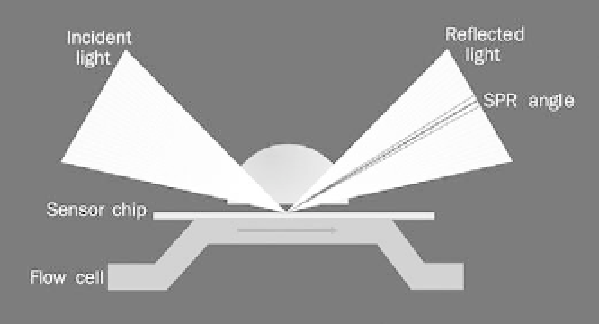Biomedical Engineering Reference
In-Depth Information
FIGURE 10.43
Principle of a surface plasmon resonance (SPR) detection system.
Courtesy of Biacore AB, Uppsala,
Sweden.
SPR is generally used for sensitive measurement of variations in the refractive index of
the medium immediately surrounding the metal film. For example, if an antibody is bound
to or absorbed into the metal surface, a noticeable change in the resonance angle can be
readily observed because of the change of the refraction index at the surface if all other
parameters are kept constant. The advantage of this concept is the improved ability to
detect the direct interaction between antibody and antigen as an interfacial measurement.
10.7 EXERCISES
1.
Give an example of a biomedical transducer that is used to monitor patients in the intensive
care unit.
2.
Discuss the important considerations in the selection of materials for packaging of an
implantable biosensor.
3.
Estimate the response time of an airflow transducer to monitor changes in breathing rate.
4.
Explain why low drift is an important specification for implantable sensors.
5.
The calibration tests of a new pressure transducer produced the readings in Table 10.4.
(a)
Plot the input-output calibration for this transducer.
(b)
Find the offset for readings between 0 to 200 mmHg.
(c)
Find the sensitivity for readings between 0 to 200 mmHg.
(d)
Estimate the average sensitivity for readings ranging between 200 to 300 mmHg.
(e)
State whether the response of this transducer over the entire measurement range is linear
or nonlinear.
6.
Suggest a method to measure hysteresis in a blood flow transducer.
7.
Discuss the problem of using a pressure transducer with hysteresis to monitor blood
pressure.
8.
Explain how the accuracy of a new temperature sensor can be determined.
9.
Two identical silver electrodes are placed in an electrolyte solution. Calculate the potential
drop between the two electrodes.


